Our students at CEFA Early Learning schools have always loved the book snowmen at night, they want to read it over and over again! It is very well written and beautifully illustrated. It is a wonderful story to read together and is such a great way to welcome the winter. Enjoy the story, explore the illustrations, imagine what else the snowmen are up to and fully explore every aspect of the book together. The rhyming in the text is excellent for strengthening your child’s phonemic awareness. But reading the book is just the beginning! Below are some fun activities to do after reading the book, that work on many skills essential for learning to read, learning vocabulary, math, writing, the dramatic arts and other skills.
Best Ages for This Activity
Zero to five
Activity 1: Read and Discuss the Book Together
You will need:
- The book. It is a very nice book to own and your child will want to read it time and again. Some of the extended learning activities I share with you will need the book for them as well, but if you cannot purchase it and cannot borrow it from the library, the video below reads the story for you.
Let’s get started!
- Invite your child to read the book together. While reading, pause to discuss the book as you read. For example:
- What do you think showmen do at night? I don’t think they move from their spot, do you? Let’s see what they say in this book
- Do you know how to build a snowman? Should we try next time it snows?
- Do you think snowmen slide down the streets to meet at the park? That is funny! Imagine!! (when you get to that page)
- Why do you think they drink ice cold cocoa instead of cocoa?
- Look at the beautiful illustrations together. Notice how much fun the snowmen are having, and how happy they seem to be playing in the snow together with friends.
- Talk about your child’s friends – who do they like to play in the snow with? What do they like to do when they play in the snow?
- Have they ever built a snowman? Would they like to? How tall would they build it?
- Just talk about the book, what they notice, what they like, what else they think about when they are reading it.
- Notice any new vocabulary and teach your child the new words, as well as how to use them. Review them over the next few weeks where appropriate.
Activity 2: Draw One Image the Book Makes You Think About
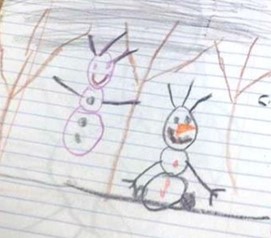
You will need:
- The book (to refer to).
- Any piece of paper (or your child can use their journal)
- Coloured pencils
Let’s get started!
- Ask your child what their favourite part of the book was, and invite them to draw it
- If they can write (many of our CEFA Early Learning school students can by age four), invite them to write a sentence about it as well (for example: If I were a snowman at night, I would build another snowman to have as a friend)
- You can add a title to their drawing together (or you can do that first if you prefer) so they remember what book they read.
Activity 3: Use play dough to explore the story
You will need:
- White play dough: You can buy this set which already comes in winter colours. If you don’t have enough white for all the snowmen you plan to build, you can get just white. I will also post an activity later this week that’ll teach you how to make your own!
- The book (to refer to).
- An easy to wipe surface where you can build a little town for your snow people to play at night. If you want, why not add a flashlight or Christmas lights and play when it gets darker? So fun!
- Anything else you can use to make houses (like pieces of carboard) a hill, a skating rink (it can be an old mirror), etc.
Let’s get started!
Read the book snowmen at night and re-create scenes of the book for dramatic play! This will teach your child reading comprehension and dramatic play.
Start by building your snow people. Build as many as you like! Build snow mothers, snow fathers, snow babies, whatever your child want to build! Make your own snow people factory to do this!
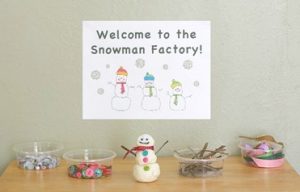
If you build the scenes described in the book (for example, the skating rink, or the mountain where they go sledding), you add S.T.E.M. learning to this reading comprehension activity. You don’t have to use play dough to build everything! Use anything you find around the house, from big milk jugs to make hills to a mirror for the skating rink, or cups, wood and sticks. Use pine tree branches you find outside to make the trees if you like!
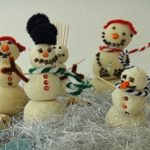
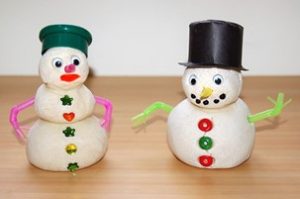
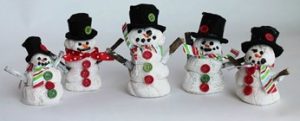
Once you have your snowmen and their play space, just play! Pretend they are sledding, or drinking a chocolate milk, or racing! You don’t have to stay with your child the whole time, let them explore this play invitation on their own as well. It is good for children to play on their own and use their imagination without relying on you for help.
Leave the installation for as long as your child shows interest. It can be weeks! As the days pass, think of other things the snow people could do. For example, build them little beds together so they can sleep after so much play. Or build them a spaceship and see if they want to visit another planet, or put a train set through the town so the snowmen can take the train whenever they want – anything your child wants to try! This activity is great for reading comprehension, imagination and creativity, as well as dramatic play.
Activity 4: Write a List of Activities to Do
This activity is an excellent writing and literacy exercise. Your child will understand the need for expressing themselves in the written language by making a list. Part of learning to write is feeling the desire and need to write (in this case, to write down ideas so we don’t forget them). If your child cannot yet write, they can draw, or they can ask you to help them write the list. If you are the one writing the list, make sure they are watching you write it, and name every word as you write it, so they understand that each work they say is written down. For example, say “go ice skating” as you write it. Here are more detailed instructions:
You will need:
- The book (to refer to).
- A pad of paper, notebook or just a simple 8½ x 11 clean piece of paper or lined paper.
- A pencil or fine tip felt pen
Let’s get started!
After reading the book, discuss with your child how much fun the snowmen seemed to be having at night (you can look at the expression of their faces, at how their bodies are moving, etc.) then ask: “would you like to do some of these things as well? What would you like to do?” and listen to your child. Some of their ideas might be from the book, and some might not (they might tell you they would want to roast marshmallows on an open fire or build an igloo). Ask open questions like “what would you do if you were a snowman and had all night to play?”
After discussing all the things you would like to do (which is excellent for building vocabulary), you can say “why don’t we make a list of all the things we want to do then start doing those things?” and that is when you write your list your child can illustrate it if they wish, instead of writing the words, or you can write the words on a separate piece of paper for them to copy onto their list (one activity at a time): “this is how you write drink hot chocolate with my friend”, or you can write it for them as they watch you say and write every work. You can explain to your child that sometimes lists start with a little box next to each item so they can tick it when they have completed the activity. Show them how to draw a square, and they can draw it at the beginning of each sentence, even if you write the rest of the words. It will give them great pleasure later to check each item they completed!
Once the list is done, place it somewhere your child can see it (for example, on the refrigerator door) and at their height. They will most likely try to read it often as they walk by, even before they can read. This is a very powerful way to teach literacy skills to your child you will be surprised at how much they learn just by being exposed to that list. They may remember the list by heart and not really be reading each word per se, but they are being exposed to the written language and how it is used.
Some items on your list (that can also be found in the book) may be:
- Build a snowman (or many) Go back to the book if you need and make a list of what you will need (ex: a carrot, a hat, a scarf, etc.)
- Make hot cocoa (what ingredients will we need? Should we try ice cold cocoa?
- Make invitations to close friends to come for cocoa and to build a snowman together (when it is safe to do so, not during the pandemic)
- Organize races with friends
- Go skating on ice
- Play in the snow
- Play snowball baseball with snowballs and a broom!
- Go sledding
- Make snowballs
Activity 5: Explore the Story by Relating it to Everyday Life
You will need:
- The book (to refer to).
- The list you created in activity 4
Let’s get started!
Now that your child wrote a list of all the things they would do if they were a snowman at night, start doing each one! It is easy to do in the winter when it gets dark so early, because it really feels like they are going out at night and doing all these things Read the list together (follow each word with your finger as you read it) and ask your child what they would like to do that day. If they want to do something that can’t be done immediately (for example, go ice skating), involve them in planning the activity. This will be less frustrating for the child than having you say no to all the ideas on the list without an explanation. Use my trick, always say “sure! Let us see how we can do it!” Here is an example:
- I want to go tobogganing!
- That sounds like so much fun! Let’s see where we can go to do that (then research together on the internet) … It says here we can go to Grouse mountain on Saturday mornings for tobogganing. Do you want to go this Saturday? Let us look at a calendar together to see when that is… it is in 4 more days! Shall we call and book it?
- I want to go tobogganing now
- Yes, that does sound like fun! Let us call to see if they are open right now… No, they only open on Saturday for that. Do you have any other ideas?
- encourage your child to solve their own problems as much as you can and as often as you can. For example, if it is a snowy day, your child might be happy to go to the part two blocks away and slide using a sheet of cardboard. If no other ideas are better than waiting till Saturday, you can move on:
- Ok let us book for Saturday and make a note on our calendars so we will not forget. In the meantime, maybe there’s something else on the list we can do today!
- We could make hot chocolate!
- Yes! Let us plan to make hot chocolate after dinner!
- But I want hot chocolate now…
- Ok, let’s get started on making it and I will make you an early dinner so you are ready to have it as soon as you finish eating – does that sound like a plan?
- Yay!
Each time you do something from the list, you can make a checkmark by it, until you have done all the items your child wanted to do. You can also invite them to plan for something to do the next day, so you can prepare in advance together. This will teach our child to organize their day and make plans. It is a good life skill to have.
Learning Opportunities
This reading activity has so many learning opportunities, aside from vocabulary, literacy and reading, that I have highlighted them throughout the document instead. I think that this will also show them how much fun grown-ups can have in the snow.
As an Amazon Associate I earn from qualifying purchases